Benefits and challenges of Building Information Modeling
Added on 2022-12-27
57 Pages18243 Words1 Views
Benefits and challenges
of Building Information
Modeling
of Building Information
Modeling
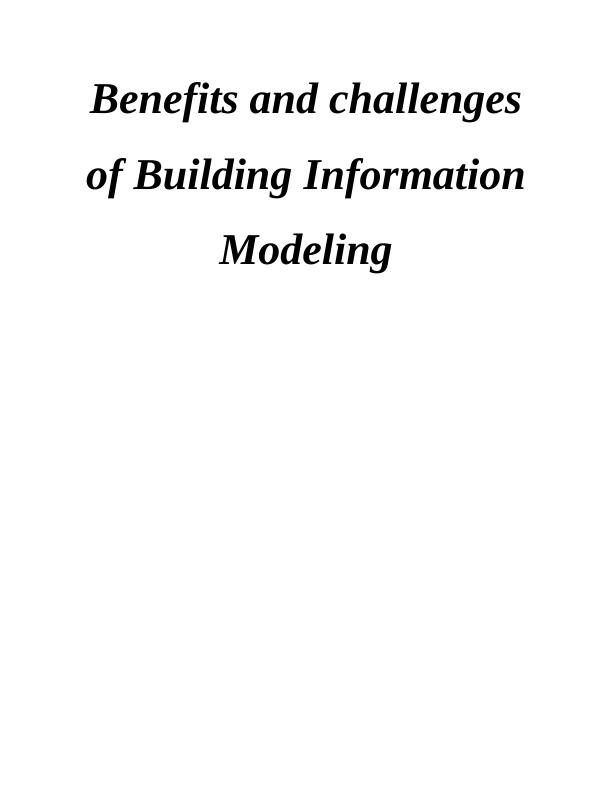
Table of Contents
Title: Benefits and challenges of Building Information Modeling. An investigation on Kier
Group plc.........................................................................................................................................1
Chapter 1: Introduction....................................................................................................................1
1.1. Overview of study...........................................................................................................1
1.2. Background of the organisation.......................................................................................2
1.3. Aims and objectives........................................................................................................2
1.4. Rationale for selection of topic........................................................................................3
1.5. Research questions..........................................................................................................3
1.6. Scope and limitation........................................................................................................4
Chapter 2: Literature review............................................................................................................4
2.1. To evaluate the concept of Building Information Modeling...........................................5
2.2. To determine about the main benefits associated with the use of Building Information
Modeling.................................................................................................................................9
2.3. To analysis the possible challenges which could be faced by an organisation or its
architecture while making use of Building Information Modeling......................................12
2.4. To recommend possible steps and effective ways for Kier group to ensure better
management of its buildings and infrastructure...................................................................14
Chapter 3: Research methodology.................................................................................................17
Chapter 4: Data analysis and interpretation...................................................................................23
4.1. Data analysis..................................................................................................................23
4.2. Interpretation of data.....................................................................................................27
Chapter 5: Research findings and communication........................................................................42
Title: Benefits and challenges of Building Information Modeling. An investigation on Kier
Group plc.........................................................................................................................................1
Chapter 1: Introduction....................................................................................................................1
1.1. Overview of study...........................................................................................................1
1.2. Background of the organisation.......................................................................................2
1.3. Aims and objectives........................................................................................................2
1.4. Rationale for selection of topic........................................................................................3
1.5. Research questions..........................................................................................................3
1.6. Scope and limitation........................................................................................................4
Chapter 2: Literature review............................................................................................................4
2.1. To evaluate the concept of Building Information Modeling...........................................5
2.2. To determine about the main benefits associated with the use of Building Information
Modeling.................................................................................................................................9
2.3. To analysis the possible challenges which could be faced by an organisation or its
architecture while making use of Building Information Modeling......................................12
2.4. To recommend possible steps and effective ways for Kier group to ensure better
management of its buildings and infrastructure...................................................................14
Chapter 3: Research methodology.................................................................................................17
Chapter 4: Data analysis and interpretation...................................................................................23
4.1. Data analysis..................................................................................................................23
4.2. Interpretation of data.....................................................................................................27
Chapter 5: Research findings and communication........................................................................42

5.1. Discussion on Research findings...................................................................................42
5.2. Communication with stakeholders and intended audience (400)..................................45
Chapter 6: Conclusion and recommendation.................................................................................45
6.1. Conclusion.....................................................................................................................45
6.2. Recommendation...........................................................................................................47
Chapter 7: Reflection.....................................................................................................................48
REFERENCES..............................................................................................................................50
5.2. Communication with stakeholders and intended audience (400)..................................45
Chapter 6: Conclusion and recommendation.................................................................................45
6.1. Conclusion.....................................................................................................................45
6.2. Recommendation...........................................................................................................47
Chapter 7: Reflection.....................................................................................................................48
REFERENCES..............................................................................................................................50
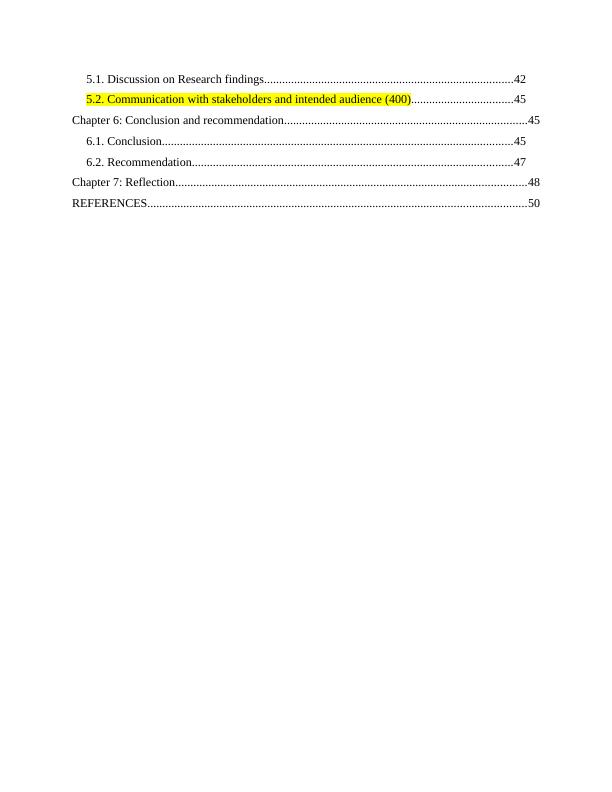
Title: Benefits and challenges of Building Information Modeling. An
investigation on Kier Group plc.
Chapter 1: Introduction
1.1. Overview of study
Building information modelling (BMI) is basically an intelligent 3D based model process
which are helpful for architecture, engineering and construction (AEC) professionals which
provide improved insight. Thus, Building Information Modeling is basically a construction tool
which is used by engineers and architecture to effectively plan, design, construct as well as
effectively managing the building and infrastructure with the help of a 3D view (Gurevich, Sacks
and Shrestha, 2017). Building information Modeling has provided an Autodesk for AEC
(architecture, engineering and constructive) Professionals to have and move towards a more
automated and collaborative form of planning, designing and manufacturing building for
ensuring more efficient and successful ways of working. The concept of BMI has become vital
and essential in construction filed as its helps in making more efficient decisions along with
improving binding performance and collaboratively works more efficiently throughout the
complete project lifecycle (Zhong and Huang, et. al., 2017). Apart from this, an enhanced use of
BIM is seen by architecture and civil engineers as it ensures and leads to an intelligent and
connected form of workflow which improves the overall predictability of plan and design
through offering a 3D insight. Beside this, Building information Modeling also supports and lead
out to a digitize and automated form of construction through ensuring connected and
collaborated project information along with 3D design for improved construction.
Further, the use of BIM also improves the overall mechanical, electrical and plumbing design
quality and collaborative all the activities in real time to ensure and support project delivery
process. Apart from this, increases importance and significance of building information
Modeling could also be drive from the fact that it helps in managing the design as well as the
construction of intelligent piping, structures, and processes to ensure more efficiently and
collaboratively throughout project lifecycle and at hand-off (Gao and Pishdad-Bozorgi, 2019).
But still apart from all theses benefits, some challenges are also associated with use of Building
Information Modeling which comprises of requirement substantial investment in new technology
and improved software. Thus, high cost along with incompatibility with partners as it is not
1
investigation on Kier Group plc.
Chapter 1: Introduction
1.1. Overview of study
Building information modelling (BMI) is basically an intelligent 3D based model process
which are helpful for architecture, engineering and construction (AEC) professionals which
provide improved insight. Thus, Building Information Modeling is basically a construction tool
which is used by engineers and architecture to effectively plan, design, construct as well as
effectively managing the building and infrastructure with the help of a 3D view (Gurevich, Sacks
and Shrestha, 2017). Building information Modeling has provided an Autodesk for AEC
(architecture, engineering and constructive) Professionals to have and move towards a more
automated and collaborative form of planning, designing and manufacturing building for
ensuring more efficient and successful ways of working. The concept of BMI has become vital
and essential in construction filed as its helps in making more efficient decisions along with
improving binding performance and collaboratively works more efficiently throughout the
complete project lifecycle (Zhong and Huang, et. al., 2017). Apart from this, an enhanced use of
BIM is seen by architecture and civil engineers as it ensures and leads to an intelligent and
connected form of workflow which improves the overall predictability of plan and design
through offering a 3D insight. Beside this, Building information Modeling also supports and lead
out to a digitize and automated form of construction through ensuring connected and
collaborated project information along with 3D design for improved construction.
Further, the use of BIM also improves the overall mechanical, electrical and plumbing design
quality and collaborative all the activities in real time to ensure and support project delivery
process. Apart from this, increases importance and significance of building information
Modeling could also be drive from the fact that it helps in managing the design as well as the
construction of intelligent piping, structures, and processes to ensure more efficiently and
collaboratively throughout project lifecycle and at hand-off (Gao and Pishdad-Bozorgi, 2019).
But still apart from all theses benefits, some challenges are also associated with use of Building
Information Modeling which comprises of requirement substantial investment in new technology
and improved software. Thus, high cost along with incompatibility with partners as it is not
1
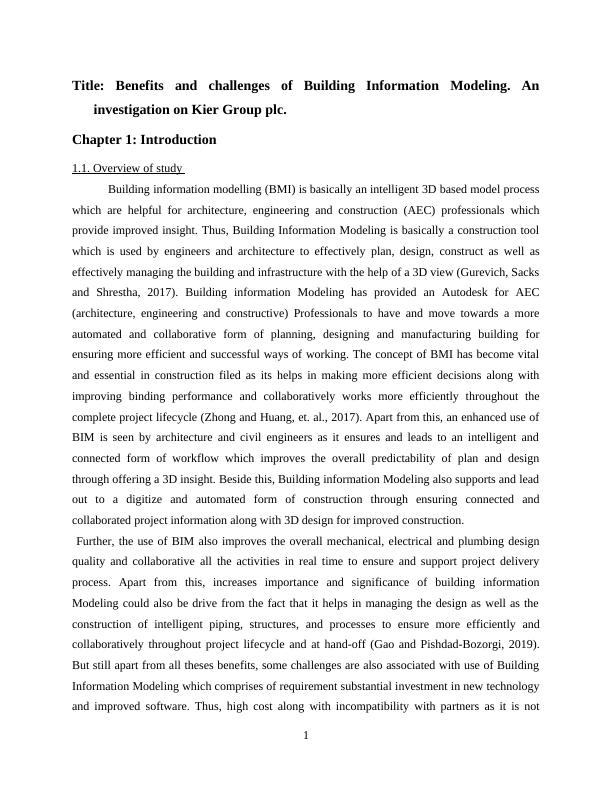
universally sued among all the constructions professionals are the major issues and challenges
associated with use of BMI in construction. Apart from this, issues of security breach and legal
consequences are also associated with use of BIM as it consists of using online network and
digital software for creation of 3D design and also involves sharing of information on network.
Therefore, current investigation is lead out on the topic of Benefits and challenges of Building
Information Modeling to get a deep insight about the concept of BIM along with analysing its
overall impact and efficiency on improving the performance and success of construction.
1.2. Background of the organisation
The organisation which have been selected for conducting and carry out current
investigation is Kier Group plc which is a famous UK construction company which comprises of
many services and property group activities associated with building and civil engineering. The
Kier Group Plc is famous and well known for its support services comprises of public and
private housebuilding contracts along with Private Finance initiative and land development. The
Kier group plc was founded in 1928 which is initially having specialisation in concrete
engineering filed and after that it keeps on expanding into general contracting as well as in house
building (Luthra and Mangla, 2018). Kier group is among one of the top UK construction
company and contractor builder but still threat of high level of competition is still faced by Kier
Plc group. Thus, having continuous improvement in its operations and setting a balance with
regular upgrading technology and ongoing advancement in engineering and construction filed
has become vital for Kier Group Plc. therefore current investigation is lead out on Kier group Plc
to ensure better analysis about the concept of Building information Modeling (BIM) along with
analysing its main benefits and challenges.
1.3. Aims and objectives
Research aim
The aim of current investigation is, “To understand the concept of Building information
Modeling (BIM) along with analysing its main benefits and challenges”. A research project on
Kier Group.
Research Objectives
The main objectives set out for current investigation to meet the above stated aim are
provided as follows:
To evaluate the concept of Building Information Modeling.
2
associated with use of BMI in construction. Apart from this, issues of security breach and legal
consequences are also associated with use of BIM as it consists of using online network and
digital software for creation of 3D design and also involves sharing of information on network.
Therefore, current investigation is lead out on the topic of Benefits and challenges of Building
Information Modeling to get a deep insight about the concept of BIM along with analysing its
overall impact and efficiency on improving the performance and success of construction.
1.2. Background of the organisation
The organisation which have been selected for conducting and carry out current
investigation is Kier Group plc which is a famous UK construction company which comprises of
many services and property group activities associated with building and civil engineering. The
Kier Group Plc is famous and well known for its support services comprises of public and
private housebuilding contracts along with Private Finance initiative and land development. The
Kier group plc was founded in 1928 which is initially having specialisation in concrete
engineering filed and after that it keeps on expanding into general contracting as well as in house
building (Luthra and Mangla, 2018). Kier group is among one of the top UK construction
company and contractor builder but still threat of high level of competition is still faced by Kier
Plc group. Thus, having continuous improvement in its operations and setting a balance with
regular upgrading technology and ongoing advancement in engineering and construction filed
has become vital for Kier Group Plc. therefore current investigation is lead out on Kier group Plc
to ensure better analysis about the concept of Building information Modeling (BIM) along with
analysing its main benefits and challenges.
1.3. Aims and objectives
Research aim
The aim of current investigation is, “To understand the concept of Building information
Modeling (BIM) along with analysing its main benefits and challenges”. A research project on
Kier Group.
Research Objectives
The main objectives set out for current investigation to meet the above stated aim are
provided as follows:
To evaluate the concept of Building Information Modeling.
2

To determine about the main benefits associated with the use of Building Information
Modeling.
To analysis the possible challenges which could be faced by an organisation or its
architecture while making use of Building Information Modeling.
To recommend possible steps and effective ways for Kier group to ensure better
management of its buildings and infrastructure.
1.4. Rationale for selection of topic
The selection of current research topic based on the concept of Building information
Modeling is rationale and significant as it provides a more effective and automated way of
construction and designing for engineers and architecture. Vital understanding about the concept
of BIM has become increasingly important for all architects and engineers as it allows them to
set a better collaboration and involvement with clients and stakeholders. Apart from this,
understanding about the BIM is also become significant to effectively design and create an
effective built environment through use of 3D design and also save time and money along with
helping in competing a construction project in efficient manner. Therefore, selection of current
research topic based on analysing benefits and challenges associated with BIM is rationale and
justifiable as BIM ensures an improved coordination and communication at work site along with
facilitating greater efficiency level and shorter project lifecycle which improves the quality of
overall results.
Apart from providing better understanding and knowledge about the concept of BIM,
selection of current research project is also vital and rationale from personal view point of
researcher as this topic meets its personal interest. Along with this, topic of Benefits and
challenges of Building Information Modeling is also complying with academic and educational
perspective of investigator. Apart from this, leading out current investigation also ensures and
leads out improvement in the managerial skills and other interpersonal competencies like
communication and time management of researcher which would support better personal and
professional growth in future.
1.5. Research questions
Following research questions would be analysed and evaluated through current
investigation on Kier Group:
What is meant by the concept of Building Information Modeling?
3
Modeling.
To analysis the possible challenges which could be faced by an organisation or its
architecture while making use of Building Information Modeling.
To recommend possible steps and effective ways for Kier group to ensure better
management of its buildings and infrastructure.
1.4. Rationale for selection of topic
The selection of current research topic based on the concept of Building information
Modeling is rationale and significant as it provides a more effective and automated way of
construction and designing for engineers and architecture. Vital understanding about the concept
of BIM has become increasingly important for all architects and engineers as it allows them to
set a better collaboration and involvement with clients and stakeholders. Apart from this,
understanding about the BIM is also become significant to effectively design and create an
effective built environment through use of 3D design and also save time and money along with
helping in competing a construction project in efficient manner. Therefore, selection of current
research topic based on analysing benefits and challenges associated with BIM is rationale and
justifiable as BIM ensures an improved coordination and communication at work site along with
facilitating greater efficiency level and shorter project lifecycle which improves the quality of
overall results.
Apart from providing better understanding and knowledge about the concept of BIM,
selection of current research project is also vital and rationale from personal view point of
researcher as this topic meets its personal interest. Along with this, topic of Benefits and
challenges of Building Information Modeling is also complying with academic and educational
perspective of investigator. Apart from this, leading out current investigation also ensures and
leads out improvement in the managerial skills and other interpersonal competencies like
communication and time management of researcher which would support better personal and
professional growth in future.
1.5. Research questions
Following research questions would be analysed and evaluated through current
investigation on Kier Group:
What is meant by the concept of Building Information Modeling?
3
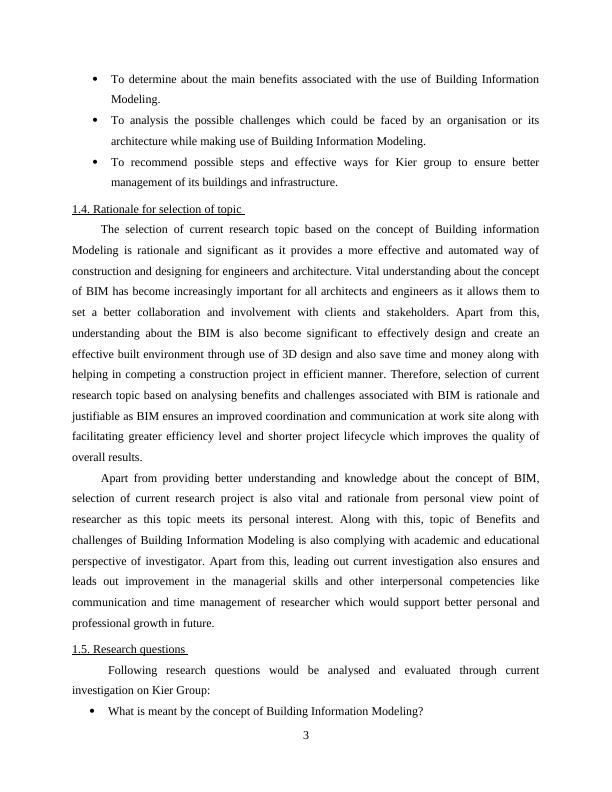
Which are the main benefits associated with the use of Building Information Modeling?
What could be the possible challenges which could be faced by an organisation or its
architecture while making use of Building Information Modeling?
What are recommended steps and effective ways for Kier group to ensure better
management of its buildings and infrastructure?
1.6. Scope and limitation
The current dissertation is having a wide scope as it facilitates better understanding about
the concept of Building Information Modeling which is made the designing and construction of
building more efficient and effective. The use of BIM facilitates a much more automated and
efficient tool for architecture and engineer for effective construction and designing of a building
through ensuring 3D and better view. Further, an implication about the possible challenges
which could be faced by an organisation or its architecture while making use of Building
Information Modeling is also provided by current study which ensures for effective mitigation of
these challenge to have improved utilisation of BIM technique which enhance its future scope.
Effective recommendation is also provided through current study to ensure better management of
its buildings and infrastructure. The main limitation faced during current investigation is related
with lack of time which has hampered the efficiency level of study. Apart from this, maintaining
authenticity and reliability of collected data is also a challenge encountered during the current
study.
Chapter 2: Literature review
It forms out a vital part of every dissertation and research project which yields a systematic
analysis of secondary form of data which facilitates and provides a base for conducting and
leading out an investigation. Thus, an implication can be made out that a literature review is
basically a type of review article of scholarly paper that presents the current knowledge including
substantive findings as well as theoretical and methodological contributions to a particular topic
(Anand and Amor, 2017). The current literature review is based on the topic of Benefits and
challenges of Building Information Modeling and its objective for which a range of articles has
been reviewed and survey, a discussion and analysis of which is provided as below:
4
What could be the possible challenges which could be faced by an organisation or its
architecture while making use of Building Information Modeling?
What are recommended steps and effective ways for Kier group to ensure better
management of its buildings and infrastructure?
1.6. Scope and limitation
The current dissertation is having a wide scope as it facilitates better understanding about
the concept of Building Information Modeling which is made the designing and construction of
building more efficient and effective. The use of BIM facilitates a much more automated and
efficient tool for architecture and engineer for effective construction and designing of a building
through ensuring 3D and better view. Further, an implication about the possible challenges
which could be faced by an organisation or its architecture while making use of Building
Information Modeling is also provided by current study which ensures for effective mitigation of
these challenge to have improved utilisation of BIM technique which enhance its future scope.
Effective recommendation is also provided through current study to ensure better management of
its buildings and infrastructure. The main limitation faced during current investigation is related
with lack of time which has hampered the efficiency level of study. Apart from this, maintaining
authenticity and reliability of collected data is also a challenge encountered during the current
study.
Chapter 2: Literature review
It forms out a vital part of every dissertation and research project which yields a systematic
analysis of secondary form of data which facilitates and provides a base for conducting and
leading out an investigation. Thus, an implication can be made out that a literature review is
basically a type of review article of scholarly paper that presents the current knowledge including
substantive findings as well as theoretical and methodological contributions to a particular topic
(Anand and Amor, 2017). The current literature review is based on the topic of Benefits and
challenges of Building Information Modeling and its objective for which a range of articles has
been reviewed and survey, a discussion and analysis of which is provided as below:
4
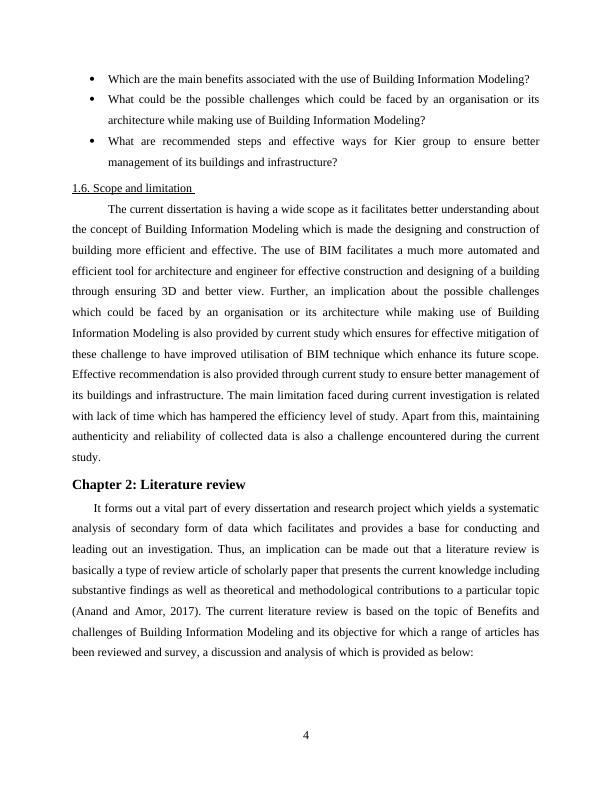
2.1. To evaluate the concept of Building Information Modeling.
As per the information provided by the Shimonti Paul, 2018, the BIM which is short for
Building Information Modeling is basically an intelligent processor based on a 3D model that
provides engineers, architecture and other construction professional an improved insight during
the building and construction process. An implication has been made out that, BIM is a vital tool
which has enhanced the efficiency level of plan, design and construction through ensuring
effective building management and improved level of infrastructure. Apart from this, it has been
analysed that the concept of BMI is helping out AEC (Architecture, Engineering and
construction) Professionals through leading a more automated and collaborative tool for having
an improved way of designing and construction which ensure and leads to more successful ways
of working (BIM Use by Architecture, Engineering, and Construction (AEC) Industry in
Educational Facility Projects, 2019). It has been observed that the concept of Building
information Modeling (BIM) is referred to a collaborative way of working which comprises of
methods based on the generation and effective exchange of data and other vital information
among the various parties of projects. Thus, an effective implication and use of BIM requires a
vital integration among the five main elements of a project which forms integrated part of the
concept of BMI (Hu and et. al., 2019).
These five vital elements of BMI comprise of Process, Policies, People, Information and
technologies among which a proper coordination and collaboration is vital and important for
effective use and improved implication of BIM model. A description and evaluation about these
five elements of BIM model is provide as below:
5
As per the information provided by the Shimonti Paul, 2018, the BIM which is short for
Building Information Modeling is basically an intelligent processor based on a 3D model that
provides engineers, architecture and other construction professional an improved insight during
the building and construction process. An implication has been made out that, BIM is a vital tool
which has enhanced the efficiency level of plan, design and construction through ensuring
effective building management and improved level of infrastructure. Apart from this, it has been
analysed that the concept of BMI is helping out AEC (Architecture, Engineering and
construction) Professionals through leading a more automated and collaborative tool for having
an improved way of designing and construction which ensure and leads to more successful ways
of working (BIM Use by Architecture, Engineering, and Construction (AEC) Industry in
Educational Facility Projects, 2019). It has been observed that the concept of Building
information Modeling (BIM) is referred to a collaborative way of working which comprises of
methods based on the generation and effective exchange of data and other vital information
among the various parties of projects. Thus, an effective implication and use of BIM requires a
vital integration among the five main elements of a project which forms integrated part of the
concept of BMI (Hu and et. al., 2019).
These five vital elements of BMI comprise of Process, Policies, People, Information and
technologies among which a proper coordination and collaboration is vital and important for
effective use and improved implication of BIM model. A description and evaluation about these
five elements of BIM model is provide as below:
5
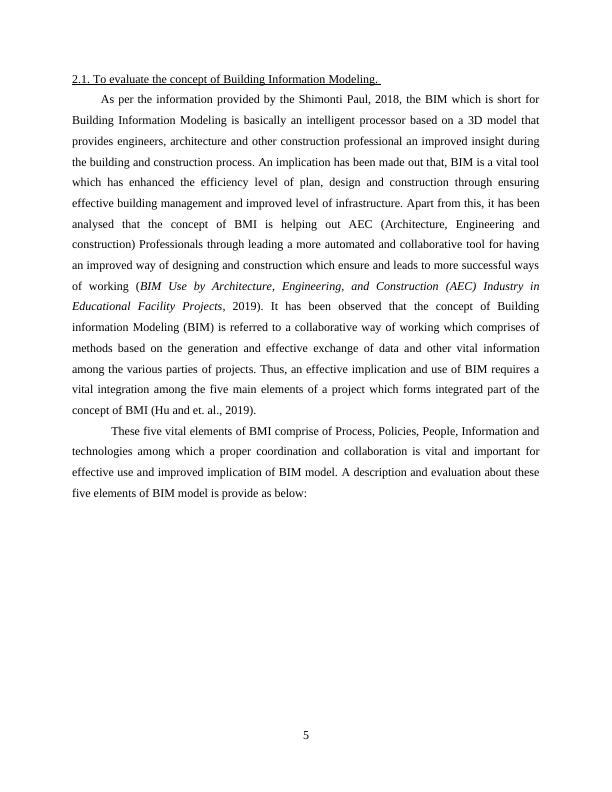
End of preview
Want to access all the pages? Upload your documents or become a member.
Related Documents
KB7034: Building Information Modelling Managementlg...
|10
|2641
|405
Benefits of Using BIM in Construction Projectslg...
|17
|7340
|121
The Contribution of DYNAMO Visual Programming Software in the Evolution of BIMlg...
|50
|19073
|28
BIM for Health and Safety in Constructionlg...
|15
|5021
|128
Adoption of BIM Within the UK Construction Report 2022lg...
|9
|4309
|31
Impact of Building Information Modeling (BIM) on People Management Processes in Construction SMEslg...
|11
|3491
|70
